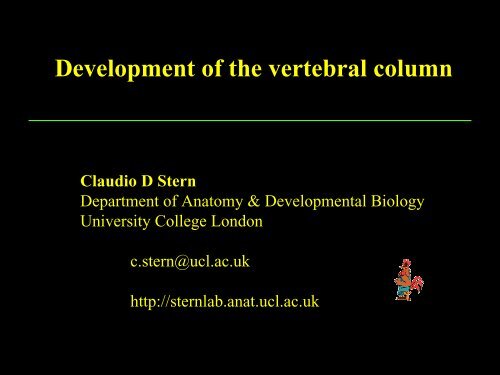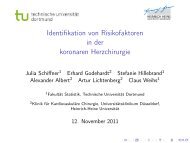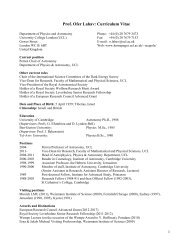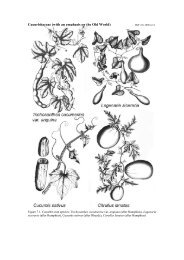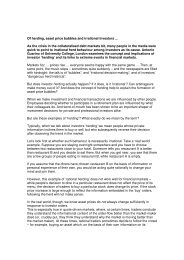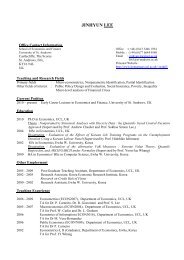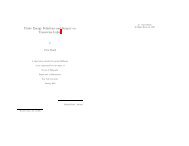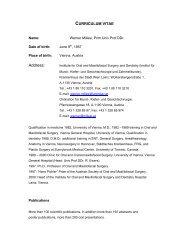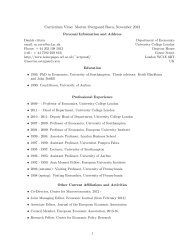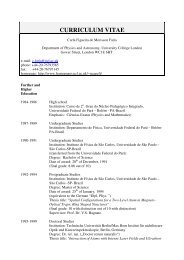Development of the vertebral column - UCL
Development of the vertebral column - UCL
Development of the vertebral column - UCL
Create successful ePaper yourself
Turn your PDF publications into a flip-book with our unique Google optimized e-Paper software.
<strong>Development</strong> <strong>of</strong> <strong>the</strong> <strong>vertebral</strong> <strong>column</strong><br />
Claudio D Stern<br />
Department <strong>of</strong> Anatomy & <strong>Development</strong>al Biology<br />
University College London<br />
c.stern@ucl.ac.uk<br />
http://sternlab.anat.ucl.ac.uk
Segmentation <strong>of</strong> <strong>the</strong> nervous system and skeleton
Somite formation progresses from head to tail
Embryo:<br />
C<br />
R<br />
C<br />
R<br />
C<br />
R<br />
C<br />
R<br />
notochord<br />
Adult:<br />
muscle<br />
muscle muscle muscle<br />
vertebra<br />
vertebra<br />
vertebra
Model 1: parasegmental relationship<br />
(Neugliederung – resegmentation)<br />
Model 2: segmental relationship<br />
1 somite => 1 vertebra
Model 1: Resegmentation – <strong>the</strong> classical view<br />
(Remak, 1855)
Model 2: 1 somite => 1 vertebra<br />
We still don’t really know <strong>the</strong> answer for sure…
How do <strong>the</strong> vertebrae (somites) and nerves relate to one ano<strong>the</strong>r?<br />
… <strong>the</strong> textbook view
How do <strong>the</strong> vertebrae (somites) and nerves relate to one ano<strong>the</strong>r?<br />
take a look …<br />
Motor nerves (and sensory) only in rostral half <strong>of</strong> somite!
Is this a property <strong>of</strong> <strong>the</strong> nervous system, or <strong>of</strong> <strong>the</strong> somites?<br />
Neural tube<br />
rotation<br />
Somite<br />
mesoderm<br />
rotation
How do rostral and caudal half cells interact?<br />
Multiple-rostral<br />
somites
How do rostral and caudal half cells interact?<br />
Multiple-caudal<br />
somites
Tentative rule:<br />
Whenever “like” cells are adjacent, <strong>the</strong>y mix. Unlike cells<br />
generate a border.<br />
… but <strong>the</strong>n <strong>the</strong>re should also be a border in <strong>the</strong> middle <strong>of</strong> each somite?<br />
“von Ebner’s fissure”
When is <strong>the</strong> decision to segment made? Try heat-shock…
Heat-shock produces not one, but multiple,<br />
repeated anomalies, 7-somites apart!
Since 1 pair <strong>of</strong> somites forms every 90 minutes, 7 somites ~ 10 hours<br />
What process could be 10 hours long? The cell cycle?
Cell cycle synchrony for cells that segment toge<strong>the</strong>r…
Synchrony can even by seen directly – looking at mitoses:
A cell cycle model for segmentation
Ano<strong>the</strong>r clock (oscillator): Notch signalling
Expression <strong>of</strong> chick Hairy-1 oscillates in presomitic mesoderm
But we still don’t know whe<strong>the</strong>r <strong>the</strong> Notch oscillator plays<br />
a direct role in regulating ei<strong>the</strong>r <strong>the</strong> timing <strong>of</strong> segmentation<br />
or <strong>the</strong> size <strong>of</strong> somites.<br />
Ano<strong>the</strong>r hypo<strong>the</strong>sis is that it is involved in regulating <strong>the</strong><br />
alternation between rostral and caudal sclerotome properties.
What makes cells become somites in <strong>the</strong> first place?
Movement <strong>of</strong> Hensen’s node cells into notochord<br />
Anterior primitive streak cells give rise to somites
Fate map <strong>of</strong> <strong>the</strong> primitive streak
Conclusions:<br />
BMP signalling (inhibited by Noggin) regulates <strong>the</strong> decision between<br />
somitic and lateral plate mesoderm.<br />
It is possible to induce somites to form that do not have rostrocaudal<br />
polarity – <strong>the</strong>refore <strong>the</strong> decision to segment is regulated<br />
independently from <strong>the</strong> decision to become rostral or caudal half.<br />
The most parsimonious explanation at <strong>the</strong> moment is that Notch/Hairy<br />
signalling regulates Rostral/Caudal properties, and something like<br />
<strong>the</strong> cell cycle model regulates somite size and timing.<br />
If so, we don’t know how <strong>the</strong> two are coordinated.
The molecular basis <strong>of</strong> neural segmentation<br />
Peanut agglutinin binding to <strong>the</strong> caudal half somite<br />
(peanut agglutinin recognises a carbohydrate structure attached<br />
to proteins)
Assay for inhibition <strong>of</strong> axon growth: <strong>the</strong> “collapse assay”
Assay for inhibition <strong>of</strong> axon growth: <strong>the</strong> “collapse assay”
An extract from sclerotome<br />
causes axon collapse
Peanut agglutinin chromatography removes <strong>the</strong> collapsing activity<br />
PNA recognises 2 protein bands: 48 and 55 kDa.


